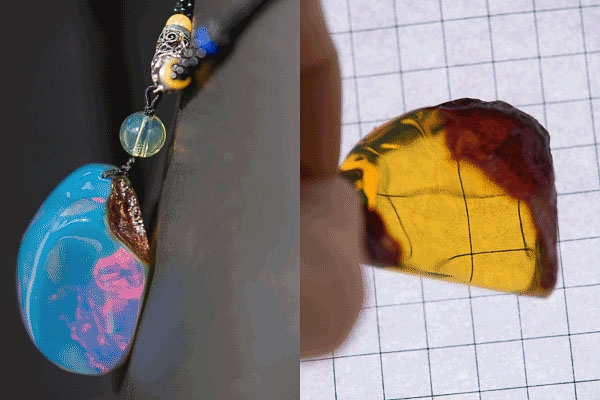Dominican Amber
A Color Enchantment
Color Spectrum in the Gem Industry
What is a Color ?
In Fact, color system is actually quite a bit more complex that it actually looks-like and in order to describ a color, professionals of the Gem Industry use a standard combination of 4 components, Body Color, Hue, Tone and Saturation.
- Bodycolor –A Gem Material Basic Color determineted by it’s Selective Absorption of Light
- Hue, which is the basic color we see on a Gem at first sight, most people refering about « Color » are actually talking about Hue.
- Tone, refers to the lightness or darkness of a Hue
- Saturation refers to the Hue’s intensity
One of the most refered tool is the Gemset designed by Pantone and The Gem Institut of America (GIA).


Is it Blue Really Blue ??
Determination of a Color in the Gem Industry
Because colored gem materials are so varied and subject to individual perception, the Gem Industry elaborate Grading Rules in order to Classify an individual Colored Gem Material.
The Hue Wheel - A 31 Hue wheel based on the 7 main Hue's – Red Orange, Yellow, Green, Blue, Violet and Purple. (Pink & Brown are not included in the Hue Wheel and as refered as "Exceptional Hue's" in the Hue Chart)
The Tone Scale – A Reference using 11 Tones from Colorless to Black. As standard, the industry only use 7 of them from Very Light to Very Dark Classification.
The Saturation Scale – Gradueted from 1 to 6 - 1 to 3 being the lower grade. Two scales are used for the saturation evaluation, one for the warm colors and one for the cool colors.




Color Perception
Subjective or Not ?
A Same Piece of Amber will Display a Dramatically
Different Hue (Percepted Color)
Phenomenal Gems
Most of Gem Materials Colors varies Slightly according to light conditions. Some of them exhibit unusual optical effects and are qualified for this reason by the industry as Phenomenal Gems.
Common Optical Effects on Phenomenal Gems are:
- Iridescence : Rainbow-like colors (Labradorite)
- Asterism : The Star Effect ( Depends Mostly of the Quality of Cut, Sapphire, Ruby Chrysoberyl…)
- Adularescence : Shimmering effect (Moonstone) Play of Colors (Opal)
- Chatoyancy : Cat Eye Effect (Chrysoberyl, Apatite, Tourmaline on Cabochon Cut Shape)
- Flame : Stombus Gigas Calcaceous Concretions (Conch Pearls)
- Color Change : We are not talking here about changes only visible by expert like for color grading but Dramatic color changes obvious even to untrained eyes. Alexandrite (Chrysoberyl), Diaspore, Fluorite as well as some variety of Garnets and Sapphire.
- Usambara Effect: Also Called « Emerald Filter Effect » is the effect in which Color varies according to the Light Path Lenght. This is a particular property of Amber, but has been observed also in some Garnets as well as in Tourmaline Specimens in which it depend specially of the type of cut.

A Gem Material Like no Other
Processed with Passion
to Craft Each of Our Creations
To Highest Level of Quality
Colors & Amber
- Specificities of the Amber Piece, Thickness, Shape, Level of Polish...
- It's own Colorimetric Particularities, Hue, Tone, Saturation
- It's Particular Chenical Composition
- Level of Inclusions (The more Included the more Saturated will be the Hue)
Light Source & Temperature (ºKelvin): Incandescent, Halogen, Discharge (Fluorescent tubes, CFL, Sodium Vapor, Metal Halide) or LED. Direct or Reflected Light. In Case of Natural Sunlight, the general conditions of the atmosphere, moment of the day (Time) Cool colors temperatures on sunrise to warmest ones on sunset, Overcast conditions...



The Very Particular
"Red Skin" Nuggets
During the Fossilization process which take over Million of years, Resin (Which turn Amber) has been deeply deposited for a very long time and exposed to various Thermal and Geological Forces. According to Geological events causing remobilization of Amber Bearings close the surface (Mountain Formations) and by consequence close the oxygen from which it was deprived, certain Amber Pieces develop a superficial very characteristic oxydation. This superficial oxydation varies from very light orange on the full spectrum to black. It brings a unique effect to a very small proportion of Dominican Amber called locally "Ambar Casca Roja or Flor de Tierra"(Red Skin or Outcrop Nuggets - Romantic traduction of Flor de Tierra being - Ground Flower), this Solid Coloration can be seen by Transmited as well as Reflected light. As this is ONLY a Supercial Oxydation, this "Layer" may desappeared according to the process of Grinding / Polishing and reveal then another coloration. Master Carvers often play with this particularity in order to achieve incredible pieces of art.

Hue - Tone - Saturation & Usambra Effect
How Many Colors Exactly...? Well, you name it...
We process everydays this Fantastic Gem Material and it Seems that everyday we Discover new Colors...
It's Actually Almost Impossible to Match the Exact Same Colors from 2 Different Nuggets





